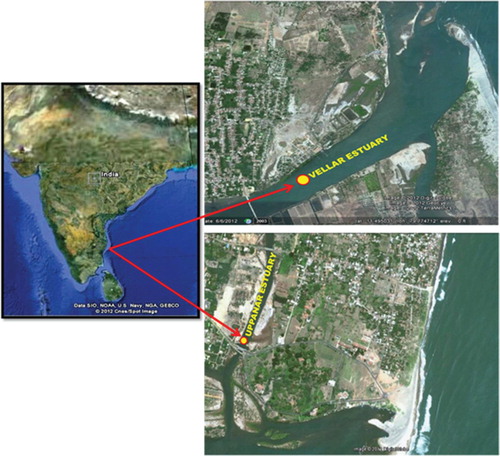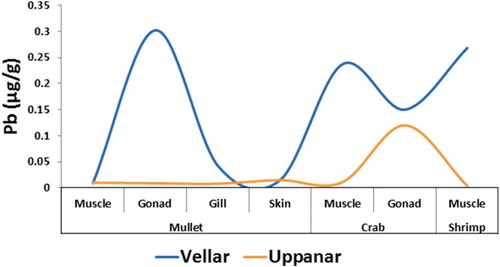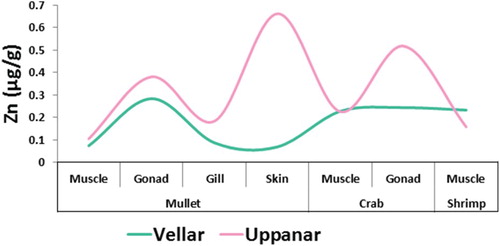 ?Mathematical formulae have been encoded as MathML and are displayed in this HTML version using MathJax in order to improve their display. Uncheck the box to turn MathJax off. This feature requires Javascript. Click on a formula to zoom.
?Mathematical formulae have been encoded as MathML and are displayed in this HTML version using MathJax in order to improve their display. Uncheck the box to turn MathJax off. This feature requires Javascript. Click on a formula to zoom.ABSTRACT
Three marine organisms Mugil cephalus, Portunus pelagicus and Penaeus indicus were gathered from the Vellar and Uppanar estuaries, Southeast Coast of India . Their muscle tissues, gills, gonads, and skin were investigated for the presence of some trace elements, by Inductively Coupled Plasma-Optical Emission Spectrometry. The results showed that the Aluminum concentration level was observed to be greatest in all of the examined marine organisms followed by Zn, Cu, Pb and Cd. The highest level of Aluminum observed in skin, gonad and gill of mullet fish followed by crab gonad and shrimp muscle respectively. Vellar estuarine organisms showed significantly lower concentrations of heavy metals compared to organisms obtained from the Uppanar estuary. The minimum level of Cadmium was observed in all the tissues of the studied marine organisms. None of the trace metals investigated in Vellar and Uppanar estuaries was over the extreme allowable level endorsed by CODEX.
1. Introduction
Heavy metals are essential components of the marine and freshwater environment, usually found in really low concentrations. The Majority part of the heavy metals released into the earth discover their way into the aquatic environment as input of direct air deposition, climatic, and disintegration due to rainwater. The level of trace metals is too high, in the area where mechanical, cultivating and mining activities are across the natural areas [Citation1,Citation2]. Trace elements constitute a genuine sort of contamination in water and being steady mixes, they are not promptly expelled by oxidation, precipitation or different procedures and influences the action in the beneficiary animals [Citation3,Citation4].
Heavy metals accumulated in the aquatic organisms by direct consumption of water and food through the digestive system or indirectly across the permeable membranes such as gills and skin. Concentration levels of heavy metals in fish organs indicate their levels in water and sediments. The level of accumulation of heavy metals in fish organs can exceed the environmental levels. The toxic effect usually occurs when the rate of uptake is exceeding the mechanism of metabolism, storage, and detoxification [Citation5].
Contamination of the aquatic environment by heavy metals has been reported by many authors such as [Citation5–8], have discovered that lead, mercury, zinc, copper, arsenic, chromium, and cadmium are the important heavy metals which contaminate the water and harmful to aquatic organisms. Many aquatic organisms (fish, shrimp, and crab) at the highest point of the natural feeding ground items and aggregates high quantities of elements from the water [Citation9,Citation10]. The basic dangerous contaminants make undesirable consequences for the fish and their effects move to the human body after using the polluted aquatic organisms and deteriorate the status of human health [Citation11–13].
The levels of dangerous contaminants in aquatic living things are a critical factor in view of their potential effects on the organisms themselves and the life status that utilize them which include individuals. Health institutions, for example, Food and Drug Administration (FDA) have started late raised stresses over the security of fisheries obtained from business sources [Citation14].
Heavy metals pollution in water also leads to changes in the chemical components of the aquatic environment, usually influences the behavioural, physiological and bloodstream patterns, cell structures ionic balance [Citation15], carbohydrate metabolism and liver function [Citation15,Citation16] of fishes. Earlier reports, also showed that industrial and domestic effluent constitute largest sources of heavy metal which contribute to the steadily increasing metallic contaminant in aquatic and terrestrials environment in most part of the world [Citation17].
The system of the dangerous movement of trace elements on the aquatic organism fluctuates. The greater part of the metals have a fondness for amino acids and the SH get-togethers of proteins: finally, they are considered as toxic substances [Citation18]. Accumulation of heavy metals on fish negatively affects growth, development, nourishment, reproduction and fish survival by affecting their physiological, biochemical, genetic, systematic and metabolic functions [Citation19]. Different authors have reported that heavy metal concentration causes a huge decline in total protein and total lipid in several fish species [Citation20–22]. The metals appeared to be of most significance to fisheries consists; aluminum, chromium, press, nickel, copper, zinc, arsenic, cadmium, mercury and lead [Citation23,Citation24]. A considerable lot of these metals are utilized as a part of fish cultivating and fisheries as herbicides and in the protection and treatment of some fish. The physicochemical compound properties of the water apply a strong impact on the risk of these metals to the aquatic organisms [Citation18].
Chemical and toxic investigation of the organs and tissues is critical among the most decisive action, and one of the basic method used as an important technique for the detection of pollutants. When there is a probability that the harming has been caused by metals, or for the checking of metals in fish flesh for human use, the chemical and toxic investigation is a reasonable need [Citation18].
The fundamental aim of this work is adjusted towards checking the presence of some heavy metals in different organs of some marine organisms gathered from the Uppanar and Vellar estuaries, the southeast shoreline of India, with the present pollution status of the estuarine condition.
2. Materials and methods
2.1. Location
The Uppanar estuary (Figure ), is situated at Cuddalore (Lat 11°43′ Long 79°49′), which is around 25 km far from the Parangipettai coast. It begins from the northeast portion of the Shervarayan slopes and opens into the Bay of Bengal close to Cuddalore. Vellar estuary (Figure ), is arranged on the southeast shore of India in Lat. 11°29′N; Long 79° 46′E. It has a year-round association with the open ocean.
2.2. Sampling and heavy metals determination
Three cateogries of marine organisms Mullet fish (Mugil cephalus), Shrimp (Penaeus indicus) and Crab (Portunus pelagicus) were gathered from both estuaries for the present study (Table ). All specimens were arbitrarily gathered and acquired from fishermen from both estuaries. These organisms were packed in clean zipped polythene bags and transported to the research facility of Center of Advanced Study in Marine Biology, in an ice-filled polystyrene protection box. Samples were cleaned from sticky materials and put in the research centre laboratory freezer at −20°C to decrease organic decay before and during the investigation. Samples were dealt with and flushed with distilled water before dissection for the isolation of the accompanying organs: gills, muscle tissues, gonads for shrimp and crab in addition to the skin for mullet.
Table 1. Information on the classification and weight of studied marine organisms during the study period.
These organs were dissected out into little pieces with stainless-steel scissors and honed blades. The tissues were washed with Milli-Q water and dried at 80°C for 12 h and ground to fine powder with mortar and pestle. The dried tissue powder was measured precisely to the closest (1 g) and exchanged to a glass container. 10 ml of concentrated acid (60% HNO3: 70% HCLO4) were added and left at room temperature for 12 h. The processed specimens were heated gradually to 180°C till the sample volume was diminished to 2–3 ml. Every sample was filtered and made up to 25 ml with Milli-Q water. The heavy metals were measured by Inductively Coupled Plasma Optical Emission Spectrometry (ICP-OES).
2.3. Calculation
where D = dilution factor.
2.4. Statistical analysis
The data were subjected to one-way analysis of variance (ANOVA) using the package of (IBM SPSS version 19.0) and the analysis were performed at 0.05 significance level.
3. Results
The mean measurements based on (µg/g dry weight) of heavy metals (Al, Cd, Cu, Pb and Zn) in muscle, gonad, gill and skin of mullet fish, crab and shrimp are shown in Tables – and delineated by (Figures –).
Figure 2. Aluminum level studied in marine organism tissue collected from Vellar and Uppanar estuaries.
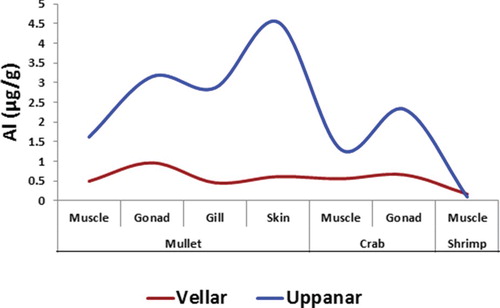
Figure 3. Cadmium level studied in marine organism tissue collected from Vellar and Uppanar estuaries.
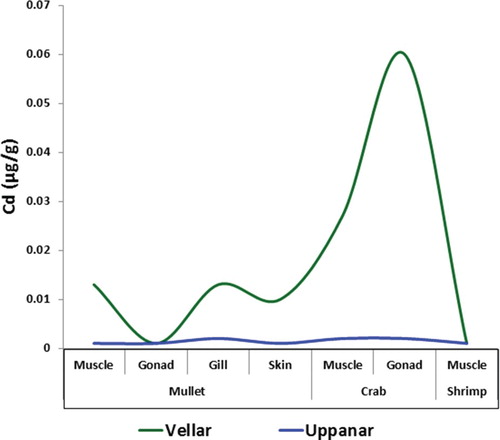
Figure 5. Copper level studied in marine organism tissue collected from Vellar and Uppanar estuaries
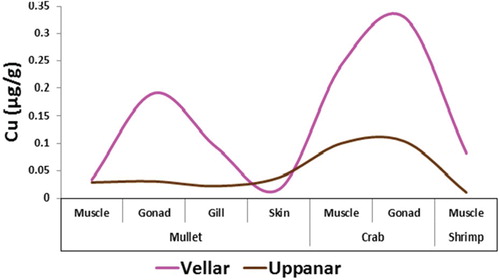
Table 2. Average concentrations of microelements (µg/g dry weight ± SD) in different organs of studied samples collected from Vellar estuary southeast coast of India during the study period.
Table 3. Average concentrations of microelements (µg/g dry weight + SD) in different organs of studied samples collected from Uppanar estuary south east of India during the study period.
Table 4. Overall concentration level of microelements (µg/g dry weight ± SD) in the whole body of marine organisms collected from Vellar Southeast Coast of India.
Aluminum concentrations ranged from 0.49 to 1.78 in Mullet muscle; crab (0.553–0.660) and shrimp (0.15–0.166); Cadmium concentrations in mullet differed from 0.005 to 0.013, from 0.004 to 0.027 in crab, and from 0.001 to 0.002 in shrimp; Copper in mullet ranged from 0.034 to 0.085, crab (0.061–0.204), shrimp (0.082–0.200); Lead in mullet (0.009–0.026), crab (0.013–0.237), shrimp (0.007–0.268); zinc in mullet (0.074–0.176), crab (0.228–0.259), shrimp (0.088–0.233) in Vellar estuary.
While it differed in same types of studied marine organisms gathered from Uppanar estuary and were observed to be somewhat around 1.618 and 12.176, crab (1.295–3.617), shrimp (0.004–0.092); Cadmium level changed from 0.005 to 0.013 in mullet muscle, from 0.004 to 0.027 in crab, and from 0.001 to 0.002 in shrimp; Copper in mullet was found to be from 0.029 to 0.120, ranged in crab muscle from 0.204 to 0.243 and from 0.010 to 0.032; the concentration of Lead was between 0.010 and 0.050 in mullet, while in crab it extended from 0.011 to −0.023, shrimp from 0.004 to −0.005; Zinc in mullet from 0.105 to 1.332, crab from 0.518 to 0.744 and shrimp from 0.158 to 0.166.
4. Discussion
Measurements of the concentration of trace elements (Cd, Cu. Al, Pb and Zn) in the flesh of the organisms are presented in Tables – and (Figures and ). According to [Citation25] concentration of heavy metals varied greatly between tissues, fish species and locations. He also reported that high metal concentration is found in the fish skin. Similarly, this study revealed that Al, Cd, Cu, Pb and Zn have been accumulated significantly (P < 0.05) different in various tissue organs including skin, gonad, gill and muscle of the studied species from both the Uppanar and Vellar estuaries (Tables –). The statistical analysis of the combined data from both sites shows high significant (P < 0.05) differences between groups and within groups. Variations in heavy metal concentration in different tissues can be related to two factors; the concentration in the environment and the organ itself. The concentrations of Aluminum metal (Al) were observed as most extreme in the skin (4.538 µg/g dry weight) and gonad (3.154 µg/g dry weight) of the Mullet fish of Uppanar estuary when contrasted with Vellar estuary. The greatest accumulation of Al in the skin, gonads and gills of mullet fish may be as a result of the skin and gill serving as respiratory organs in fishes through which metal particles are ingested as reported by [Citation25]. Variations in metal concentration between the studied sites in the same tissue-organ such as gonads, gills, skin and muscle in the same organism can be attributed to site differences in heavy metal concentration. The two sites shows Heavy metals can be taken directly through the epithelium and accumulated in the skin and gills [Citation26]. Fish gills are generally recommended as environmental indicator organs of water pollution than any other organ of the fish [Citation27]. Other possible causes include the frequent utilization of Aluminum metal in all fishing apparatuses and specialties amid the fishing and handling of fish, and not to forget that gills are in direct contact with the contaminated medium (water) and have the most slender epithelium of the considerable number of organs and metals can infiltrate through the thin epithelial cells [Citation25]. Not with standing these fish were gathered from the Cuddalore fishing harbour which was situated close to the mouth of the Uppanar estuary, and situating close to SIPCOT modern park (State Industries Promotion Council of Tamil Nadu) with 44 commercial enterprises, which include chemicals, petrochemicals, pharmaceutics, pesticides, manures and metal processing industries, other than civil and residential sewage mechanical effluents were released routinely into Uppanar estuary [Citation26]. Accumulation of heavy metals was not affected only by the fish species and tissue organs, but the water chemistry is directly affecting its accumulation [Citation5].
The minimum level of Cadmium (0.001 µg/g dry weight) was observed in all tissues of studied marine organisms. So also, the other heavy metals Cu (0.061–0.200 µg/g dry weight), Pb (0.013–0.026 µg/g dry weight) and Zn (0.158–1.332 µg/g dry weight) were recorded in various organs as least amounts in the organisms of both estuaries when contrasted and the passable level (0.05–0.1 µg/g dry weight).
None of the heavy metals examined was over the most extreme reasonable level endorsed for human by world health associations [Citation12,Citation27].
5. Conclusion
We concluded that the measured levels of Al, Cd, Cu, Pb and Zn in the organ tissues of the studied marine organisms for both estuaries were less than the permissible level set by world health advisories [Citation11,Citation13,Citation14,Citation28,Citation29].
Disclosure statement
The authors of this publication declare that they have no relevant or material financial interests that relate to the research described in this paper.
ORCID
Hassan M. A. Sulieman http://orcid.org/0000-0003-0773-8940
El Amin M. Suliman http://orcid.org/0000-0002-5580-7819
References
- Bryan G, Langston W. Bioavailability, accumulation and effects of heavy metals in sediments with special reference to United Kingdom estuaries: a review. Environ Pollut. 1992;76(2):89–131. doi: 10.1016/0269-7491(92)90099-V
- Langston W. Toxic effects of metals and incidence of marine ecosystems. In: Furness RW, Rainbow PS, editors. Heavy metals in the marine environment. New York: CRC Press; 1990. p. 256.
- Farkas A, Salanki J, Specziar A. Relation between growth and the heavy metal concentration in organs of bream Abramis brama L. populating Lake Balaton. Arch Environ Contam Toxicol. 2002;43(2):236–243. doi: 10.1007/s00244-002-1123-5
- Nammalwar P, Dalela R, Mane UE. Heavy metals pollution in Adyar Estuary, Madras, India. Muzaffarnagar: The Academy of Environmental Biology; 1985.
- Rajeshkumar S, Li X. Bioaccumulation of heavy metals in fish species from the Meiliang Bay, Taihu Lake, China. Toxicol Rep. 2018;5:288–295. doi: 10.1016/j.toxrep.2018.01.007
- Jaishankar M, et al. Biosorption of few heavy metal ions using agricultural wastes. J Environ Pollut Hum Health. 2014;2(1):1–6.
- Nagajyoti P, Lee K, Sreekanth T. Heavy metals, occurrence and toxicity for plants: a review. Environ Chem Lett. 2010;8(3):199–216. doi: 10.1007/s10311-010-0297-8
- Rashed M. Monitoring of environmental heavy metals in fish from Nasser Lake. Environ Int. 2001;27(1):27–33. doi: 10.1016/S0160-4120(01)00050-2
- Lambert M, Leven B, Green R. New methods of cleaning up heavy metal in soils and water. Environmental science and technology briefs for citizens. Manhattan (KS): Kansas State University; 2000.
- Tüzen M. Determination of heavy metals in fish samples of the middle Black Sea (Turkey) by graphite furnace atomic absorption spectrometry. Food Chem. 2003;80(1):119–123. doi: 10.1016/S0308-8146(02)00264-9
- Alinnor I, Obiji I. Assessment of trace metal composition in fish samples from Nworie River. Pakistan J Nutr. 2010;9(1):81–85. doi: 10.3923/pjn.2010.81.85
- Food U, Administration D. Fish and fishery products hazards and controls guidance. Rockville (MD): US Department of Health and Human Services, US Food and Drug Administration; 2011.
- Raja P, et al. Heavy metals concentration in four commercially valuable marine edible fish species from Parangipettai Coast, South East Coast of India. Int J Anim Vet Adv. 2009;1(1):10–14.
- Burger J, et al. Fish availability in supermarkets and fish markets in New Jersey. Sci Total Environ. 2004;333(1-3):89–97. doi: 10.1016/j.scitotenv.2004.05.016
- Oikari A, Soivio A. Physiological condition of fish exposed to water containing pulp and paper industry wastes and sewage [Europe]. FAO, Rome (Italy). Fisheries Dept. European Inland Fisheries Advisory Commission. Symposium on Biological Monitoring, Helsinki (Finland), 7 June 1976.
- Oikari A, Nakari T. Kraft pulp mill effluent components cause liver dysfunction in trout. Bull Environ Contam Toxicol. 1982;28(3):266–270. doi: 10.1007/BF01608505
- Jibiri N, Adewuyi G. Radionuclide contents and physico-chemical characterization of solid waste and effluent samples of some selected industries in the city of Lagos, Nigeria. Radioprotection. 2008;43(2):203–212. doi: 10.1051/radiopro:2007053
- Svobodová, Z. Water quality and fish health. Food & Agriculture Org. FIFAC Technical paper. No. 54. Rome: FAO; 1993. p. 59.
- Elbeshti RTA, Elderwish NM, Abdelali KMK, et al. Effects of heavy metals on fish.
- Rambhare V, Bakare R. Effect of heavy metal pollution on freshwater fishes. Proceeding International Conference Shivaji University, Kolhpur; 2012.
- Authman MM, et al. Use of fish as bio-indicator of the effects of heavy metals pollution. J Aquacult Res Dev. 2015;6(4):1–13. doi: 10.4172/2155-9546.1000328
- Chennupati S, Neelam S. Studies on selected heavy metal pollution on fresh water fishes from Krishna River Near Ibrahimpatnam (Md), Krishna (Dt), Andhra Pradesh. Life Sci Int Res J. ISSN: 2347–8691.
- Alabaster J, Lloyd R. Water quality criteria for freshwater fish. Boston (MA): Butterworth-Heinemann; 1980.
- Lloyd, R., Pollution and freshwater fish. Fishing News Books; 1992.
- Yilmaz AB. Comparison of heavy metal levels of grey mullet (Mugil cephalus L.) and sea bream (Sparus aurata L.) caught in Iskenderun Bay (Turkey). Turkish J Vet Anim Sci. 2005;29(2):257–262.
- Negi R, Maurya A. Heavy metal concentrations in tissues of major carp and exotic carp from Bhagwanpur fish pond. India J Fish Aquat Sci. 2015;10(6):543–552. doi: 10.3923/jfas.2015.543.552
- Karunanidhi K, et al. First report on the distribution of heavy metals and proximate analysis in marine edible puffer fishes collected from Gulf of Mannar Marine Biosphere Reserve, South India. Toxicol Rep. 2017;4:319–327. doi: 10.1016/j.toxrep.2017.06.004
- Alimentarius C. Codex General Standard for contaminants and toxins in food and feed. Codex Stan 193–1995; 2008. p. 9. Codex Alimentarius Commission.
- Commission E. Commission regulation (EU) no 835/2011 of 19 August 2011 amending regulation (EC) no 1881/2006 as regards maximum levels for polycyclic aromatic hydrocarbons in foodstuffs. Off J Eur Comm L. 2011;215:7–8.

